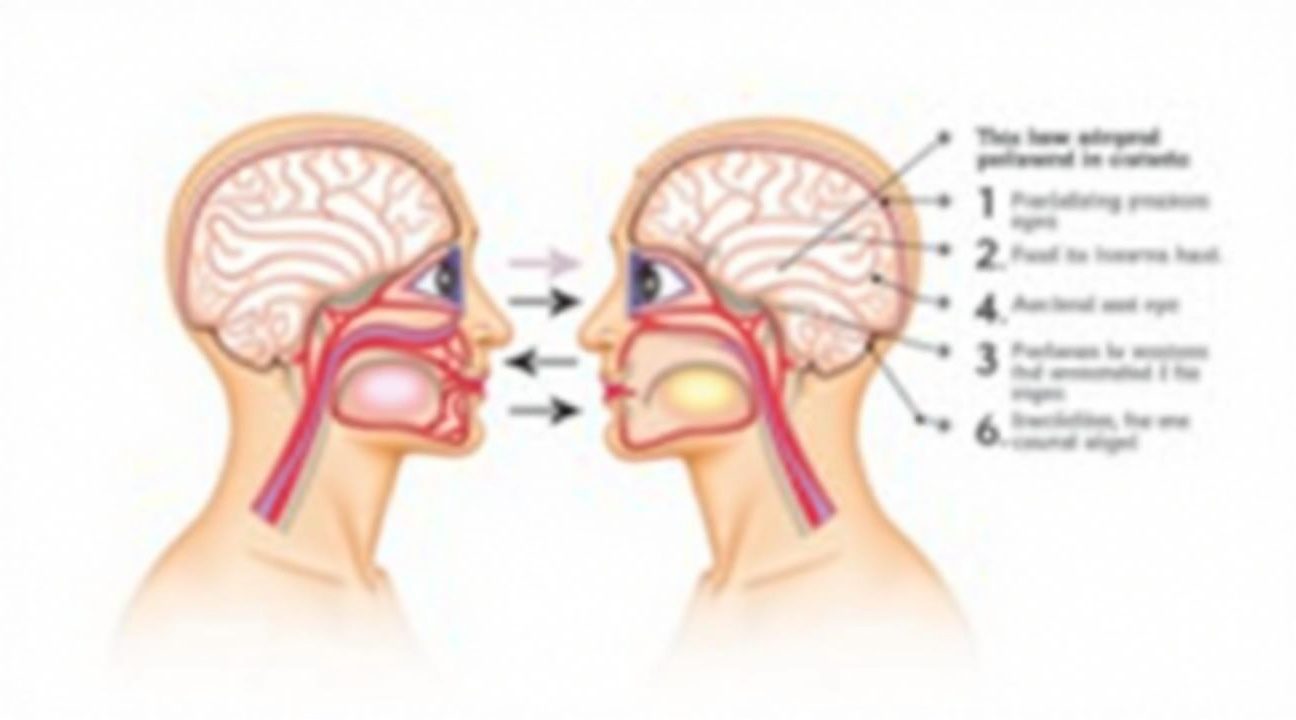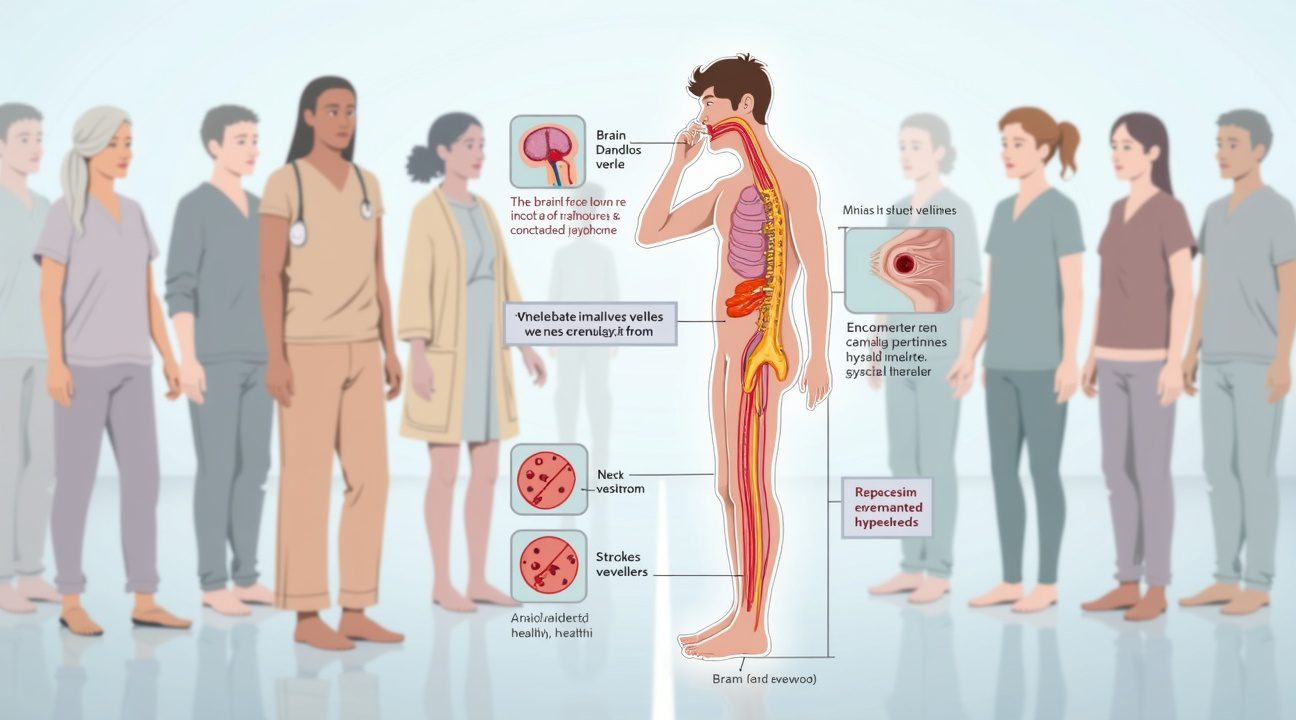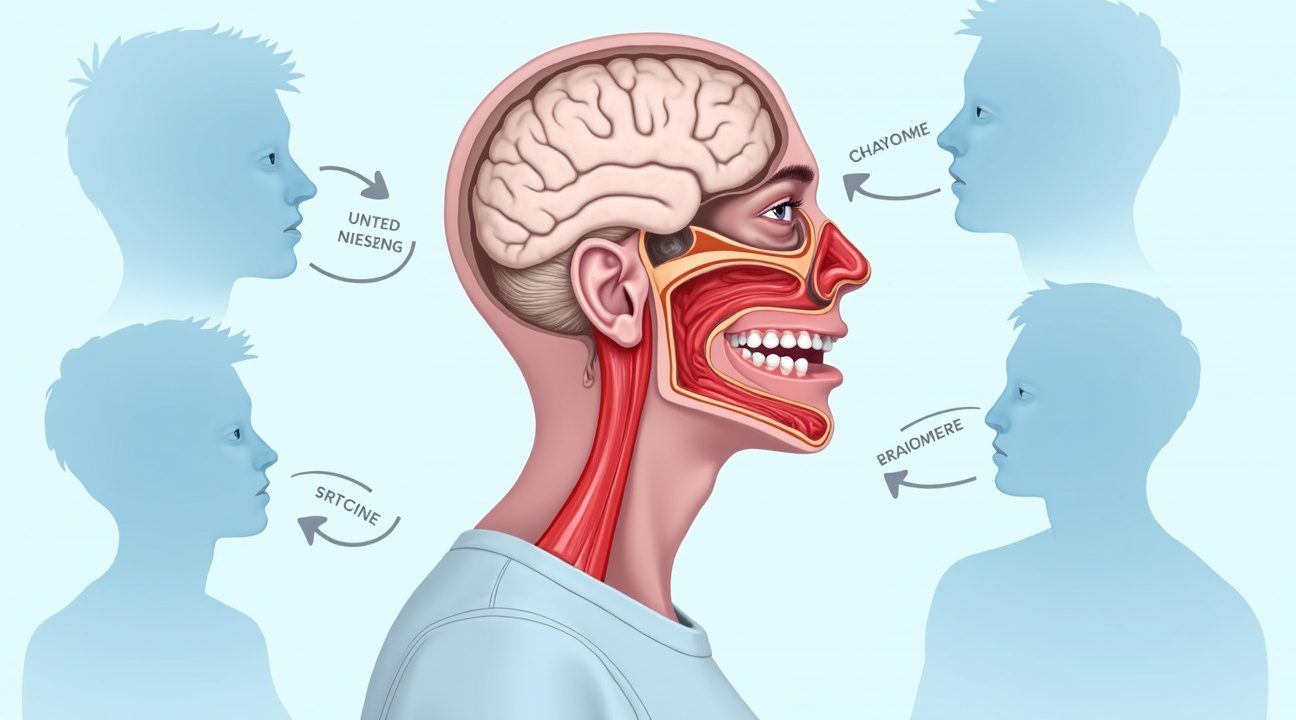Medical professionals are urgently warning the public about the serious dangers of suppressing sneezes, citing potential health risks that affect even healthy individuals.
Extreme Pressure from Sneezing Suppression
Suppressing a sneeze can generate internal pressures up to 24 times higher than what is normally experienced. In comparison to typical breathing, this pressure may spike as high as 800 times the usual respiratory pressure. Such extreme force can result in physical trauma to various internal structures.
Documented Medical Cases
One particularly striking case involved a 55-year-old man who experienced severe brain bleeding immediately after restraining a powerful sneeze. Medical reports show this occurred without any pre-existing medical conditions, confirming that healthy individuals are also at risk.
Health Risks Associated with Sneezing Suppression
- Dangerously high internal pressure may lead to blood vessel ruptures.
- Eye injuries, minor to severe, such as hemorrhaging, have been frequently observed.
- Brain and ear trauma can occur due to increased pressure in sensitive areas.
- The Valsalva mechanism intensifies pressure differences between blood vessels and surrounding tissues, escalating the risk of ruptures.
Who is at Risk?
Although individuals with vascular or blood pressure conditions are considered more vulnerable, studies show that 70% of sneeze-related medical injuries occur in otherwise healthy people. This challenges the assumption that only high-risk demographic groups are affected.
Best Practices Recommended by Medical Experts
- Do not hold in sneezes—allow them to occur naturally to prevent internal pressure buildup.
- Use proper etiquette by sneezing into a tissue or your elbow to reduce the spread of germs.
- Seek medical help if you experience persistent pain, dizziness, or unusual symptoms after a stifled sneeze.
For more information about the risks and safe practices, you can visit this Healthline article on sneeze suppression.
Excessive Pressure Build-Up Can Reach 24 Times Normal Levels
I can tell you that the pressure generated when someone holds in a sneeze creates truly alarming conditions inside the body. A regular sneeze produces an airway pressure of about 1 psi, which already represents a significant force. However, when a person suppresses this natural reflex, the pressure can skyrocket to between 5 and 24 times that level.
To put this in perspective, during normal activities like exhalation, windpipe pressure measures approximately 0.03 psi. This means that holding in a sneeze can create pressure levels up to 800 times higher than what the body experiences during regular breathing. Such extreme pressure differentials push the respiratory system far beyond its normal operating parameters.
Why This Pressure Spike Becomes So Dangerous
The human body designed sneezing as an efficient mechanism to expel irritants from the nasal passages and airways. This natural process builds pressure specifically to force out particles, allergens, or other foreign substances that could harm the respiratory system. When someone blocks this natural expulsion, the accumulated force has nowhere to go except back into the body’s tissues and blood vessels.
This redirected pressure creates several concerning scenarios:
- Blood vessels in the eyes become particularly vulnerable due to their delicate structure and proximity to the surface.
- Capillaries in the brain can face increased risk of rupture under these sudden spikes in pressure.
- Eardrums and sinuses may suffer from internal damage caused by the abrupt backflow of air.
- Soft tissues of the upper respiratory tract such as nasal passages and throat structures endure significant strain.
While understanding respiratory health has become increasingly important, many people don’t realize how these basic reflexes protect them from harm.
Medical professionals emphasize that this isn’t just a theoretical concern. The 24-fold pressure increase represents a real physiological event that can cause immediate damage to blood vessels and tissues. Unlike other bodily functions that have built-in safety mechanisms, the suppression of a sneeze essentially removes the body’s natural pressure release valve.
What makes this particularly troubling is how common it is for people to suppress sneezes in social situations. The pressure build-up happens almost instantaneously, giving tissues and blood vessels no time to adapt or compensate. This sudden spike creates conditions that can rupture small blood vessels before the body’s protective mechanisms can respond.
I’ve observed that many people don’t realize they’re creating such extreme internal conditions when they hold in a sneeze. The force that naturally wants to exit through the nose and mouth instead gets redirected into areas where it can cause serious harm. Understanding these pressure dynamics helps explain why doctors consistently recommend allowing sneezes to happen naturally rather than suppressing them for social convenience.
The comparison between normal exhalation pressure and suppressed sneeze pressure reveals just how dramatically different these forces are:
- Normal breathing creates gentle pressures manageable by the body.
- Suppressed sneezing creates explosive, high-pressure conditions that threaten delicate head and neck structures.
This makes the simple act of letting a sneeze occur naturally one of the most important protective measures someone can take for their vascular health.
Range of Serious Injuries from Brain Bleeding to Ruptured Eardrums
Medical professionals have documented an alarming array of injuries that can result from suppressing the natural reflex to sneeze. These complications span multiple body systems and range from minor discomfort to life-threatening conditions that require immediate medical intervention.
Blood vessels throughout the body face tremendous strain when someone forcefully holds back a sneeze. The intense pressure buildup can cause these delicate structures to rupture in the eyes, creating visible redness and burst capillaries that may take weeks to heal. Similarly, blood vessels in nasal regions can burst under this pressure, leading to sudden nosebleeds that can be difficult to control.
Brain-related complications represent some of the most serious risks associated with sneeze suppression. Rare cases of subarachnoid hemorrhage (SAH), a dangerous form of brain bleeding, have been linked to forcefully holding in sneezes. This condition becomes particularly concerning for individuals who already have brain aneurysms, as the additional pressure could trigger a rupture with potentially fatal consequences.
Documented Cases Across Multiple Body Systems
A comprehensive medical review has catalogued 52 documented cases of sneeze-related injuries, organizing them into six distinct categories that highlight the widespread impact of suppressed sneezes. These categories include:
- Intrathoracic injuries affecting the chest cavity and lungs
- Laryngeal and pharyngeal damage to the throat and voice box
- Ocular and orbital injuries impacting the eyes and surrounding structures
- Intracranial and neurological complications affecting the brain
- Otologic injuries involving the ears and hearing apparatus
- Other miscellaneous types of pressure-related damage
Ear-related injuries occur when redirected airflow travels through the eustachian tubes instead of exiting through the nose and mouth. This abnormal pressure can rupture eardrums, causing immediate pain, hearing loss, and potential long-term complications. Middle ear infections frequently develop as a secondary complication when bacteria enter through damaged tissues.
Throat injuries represent another category of concern, particularly when abnormal air pressure levels cause tears in delicate throat tissues. These injuries can affect swallowing, speaking, and breathing functions, requiring specialized medical treatment to prevent infection and promote proper healing.
Diaphragm tears, while extremely rare, constitute one of the most serious complications from sneeze suppression. The diaphragm muscle separates the chest cavity from the abdomen, and tears in this structure can lead to internal organ displacement and severe breathing difficulties that may require surgical repair.
The intensity of pressure generated during a suppressed sneeze can reach levels that overwhelm the body’s natural protective mechanisms. Unlike respiratory conditions that develop gradually, these injuries occur instantaneously and often without warning signs.
Medical experts emphasize that the human body evolved the sneezing mechanism as a protective reflex for good reason. When this natural process is interrupted, the redirected energy must go somewhere, and unfortunately, it often targets the most vulnerable structures in the head and neck region.
These documented cases serve as powerful reminders that what seems like a minor social courtesy can have serious medical consequences. The pressure generated during a typical sneeze can reach extraordinary levels, and when that energy cannot escape through its intended pathway, it seeks alternative routes that can cause significant tissue damage.
Understanding these potential complications helps individuals make informed decisions about whether the temporary social discomfort of sneezing publicly outweighs the genuine health risks associated with suppression. Medical professionals consistently recommend allowing sneezes to occur naturally while taking appropriate hygiene precautions to protect others.

How the Valsalva Mechanism Damages Blood Vessels
When someone suppresses a sneeze, they unknowingly trigger a physiological response called the Valsalva maneuver. This occurs when the body attempts a forced exhale against a closed or blocked airway. I’ve observed how this seemingly harmless action can create dangerous pressure changes throughout the cardiovascular system.
The Valsalva maneuver causes rapid spikes in pressure within the head and neck region. These sudden increases place significant stress on arterial walls, particularly at sites where aneurysms may already exist. Even healthy blood vessels face strain during these pressure surges, but weakened areas become especially vulnerable to damage.
Critical Pressure Changes During Sneeze Suppression
The mechanism involves two key pressure measurements that work against each other during a suppressed sneeze:
- Mean arterial pressure (MAP) increases dramatically as blood pushes harder against vessel walls
- Intracranial pressure (ICP) rises simultaneously, affecting the space around blood vessels in the brain
- The transmural pressure gradient expands dangerously as these two forces create opposing tensions
- Blood vessel walls experience maximum stress when this pressure differential reaches peak levels
This transmural pressure gradient represents the difference between internal blood pressure and external pressure surrounding the vessel walls. When I examine cases of cardiovascular complications, this differential often plays a central role in determining whether a blood vessel will maintain its integrity or rupture under stress.
The critical moment occurs when the pressure differential becomes too great for the vessel wall to withstand. Blood vessels in the brain and eyes contain thinner walls compared to major arteries elsewhere in the body. These delicate structures can’t handle the same pressure spikes that larger vessels might tolerate.
During a normal sneeze, pressure releases naturally through the nose and mouth. However, when someone blocks this release by pinching their nose or closing their mouth, all that force redirects internally. The respiratory system has no choice but to absorb the pressure that would otherwise escape harmlessly.
Vulnerable vessels face the greatest risk during these events. Pre-existing aneurysms, areas with atherosclerotic plaque, or naturally weaker vessel walls can’t handle sudden pressure increases. The combination of elevated MAP and ICP creates perfect conditions for rupture, especially when the pressure differential exceeds the structural limits of the blood vessel.
I’ve noticed that even healthy individuals can experience problems if the pressure spike is severe enough. The eye’s blood vessels are particularly susceptible because they’re smaller and more delicate than those found in other body regions. When these vessels burst, it results in the characteristic red appearance of subconjunctival hemorrhage.
Brain blood vessels present an even more serious concern. Cerebral arteries must maintain precise pressure balance to function properly. When the Valsalva maneuver disrupts this balance, the consequences can range from minor headaches to life-threatening hemorrhages. The smaller arterioles and capillaries in brain tissue are especially vulnerable to pressure-induced damage.
The duration of pressure elevation also matters significantly. A brief spike might cause minimal damage, but prolonged pressure from forcefully suppressing a sneeze increases the likelihood of vessel wall failure. This explains why some people experience symptoms immediately after holding in a particularly forceful sneeze.
Understanding these pressure dynamics helps explain why medical professionals consistently recommend allowing sneezes to occur naturally. The body’s sneeze reflex exists as a protective mechanism, and interfering with this process can redirect dangerous forces internally. Simple awareness of potential risks can prevent serious complications from what seems like a minor social courtesy.

Real Case Study: Middle-Aged Man Suffers Brain Bleeding After Single Sneeze
A documented medical case provides stark evidence of how dangerous holding in a sneeze can become. I’ve reviewed a particularly concerning incident involving a 55-year-old man who suffered a subarachnoid hemorrhage immediately after experiencing a powerful sneeze. This case demonstrates the serious neurological consequences that can result from the intense pressure changes associated with sneezing.
The patient presented to medical professionals with sudden, severe headache accompanied by right-sided numbness and weakness. CT scans revealed bleeding along the falx cerebri, a membrane that separates the brain’s hemispheres, along with the presence of hydrocephalus—a condition where fluid accumulates in the brain’s cavities. Fortunately, both conditions eventually resolved through conservative management, but the case highlights the potential severity of sneeze-related injuries.
Broader Pattern of Sneeze-Related Brain Injuries
This individual case fits into a larger pattern that medical researchers have identified. The documented incident supports findings that strenuous Valsalva-like actions, including sneeze suppression, can significantly elevate the risk of aneurysm rupture. When someone attempts to hold in a sneeze, they create the same type of internal pressure that occurs during the Valsalva maneuver—a breathing technique that increases pressure in the chest and abdomen.
Medical literature reveals several key demographic patterns in these cases:
- Males account for 81% of patients affected by sneeze-related brain bleeding
- The mean age of affected individuals is 40 years old
- Approximately 30% had predisposing conditions such as trauma or respiratory compromise
- The majority of cases occurred in otherwise healthy individuals without underlying conditions
These statistics underscore that sneeze-related brain injuries aren’t limited to those with pre-existing health problems. Even healthy adults can experience serious complications when the pressure from a suppressed sneeze becomes too intense for their vascular system to handle. The male predominance in these cases may relate to differences in sneeze intensity or suppression behaviors between genders.
Healthcare providers emphasize that allowing sneezes to occur naturally represents the safest approach. The brief discomfort of an unexpected sneeze pales in comparison to the potential consequences of forcibly containing the explosive pressure that builds up during this natural reflex. While such severe complications remain relatively rare, the documented cases serve as important reminders that our body’s reflexes exist for protective reasons.
For more in-depth information on sneeze-related injuries, you can refer to this article published on PubMed Central.
https://www.youtube.com/watch?v=eXyzT31DCjY
High-Risk Groups Include Those with Blood Vessel Disorders, But Most Injuries Occur in Healthy People
People with existing vascular conditions face significantly higher risks when they suppress sneezes, but the danger extends far beyond those with known medical conditions. I’ve found that certain groups require extra caution due to their underlying health status.
Specific Medical Conditions That Increase Risk
Individuals diagnosed with vascular disorders need to exercise particular care when feeling the urge to sneeze. Those with Ehlers-Danlos syndrome, a connective tissue disorder that affects blood vessel integrity, face especially serious consequences from sneeze suppression. The condition weakens arterial walls, making them more susceptible to rupture under sudden pressure changes.
Known aneurysms represent another major risk factor, as these already-weakened blood vessel areas can’t withstand the intense pressure spikes that occur during suppressed sneezes. A documented case involving a 12-year-old child with vascular Ehlers-Danlos syndrome illustrates this danger perfectly – the child suffered a subclavian artery rupture directly after sneezing, demonstrating how serious these complications can become.
Other conditions that may increase vulnerability include:
- Hypertension and cardiovascular disease
- Blood clotting disorders
- Previous history of stroke or brain hemorrhage
- Chronic conditions affecting blood vessel health
The surprising reality challenges common assumptions about who faces danger from sneeze suppression. Research reveals that most sneeze-related injuries actually happen to people without any identifiable risk factors. In one comprehensive review of cases, only 30% of affected individuals had known predisposing conditions, meaning 70% of injuries occurred in seemingly healthy people.
This statistic proves that sneeze suppression poses genuine risks across the general population, not just among those with obvious vulnerabilities. Healthy adults and children can experience everything from ruptured blood vessels in their eyes to more serious complications involving brain vessels. The unpredictable nature of these injuries makes prevention through proper sneezing technique crucial for everyone.
Age doesn’t appear to provide protection either, as cases have been documented across all age groups. Young, healthy individuals have experienced significant complications, dispelling the myth that only older adults or those with chronic conditions need worry about sneeze-related injuries.
The pressure generated during a suppressed sneeze can overwhelm even healthy blood vessels under certain circumstances. Respiratory health concerns have heightened awareness of proper breathing and sneezing practices, making this information more relevant than ever.
Medical professionals emphasize that the safest approach involves allowing sneezes to occur naturally rather than attempting suppression. Those with known vascular conditions should discuss proper sneezing techniques with their healthcare providers, but everyone benefits from understanding these risks.
The evidence clearly demonstrates that sneeze suppression creates genuine health hazards that extend far beyond high-risk populations. While certain medical conditions do increase vulnerability, the majority of documented injuries have occurred in people who appeared perfectly healthy before their incident. This pattern suggests that the mechanical forces involved in sneeze suppression can overcome normal physiological defenses in various circumstances.
Understanding these risks helps people make informed decisions about their sneezing habits. Rather than assuming only those with obvious health problems need concern themselves with proper sneezing technique, everyone should recognize that their blood vessels have limits. The simple act of allowing a sneeze to proceed naturally provides the safest outcome for people across all health categories.

Medical Experts Strongly Advise Against Suppressing Sneezes
Medical professionals consistently warn patients about the serious health risks associated with suppressing sneezes. I’ve learned that attempting to stop a sneeze midway through the process can create dangerous pressure buildups within the body that lead to unexpected injuries.
Doctors emphasize that sneezes serve as a natural protective mechanism that should never be interrupted. When someone tries to hold back a sneeze, the sudden redirection of air pressure can cause significant damage to delicate blood vessels throughout the head and neck region. These pressure spikes often exceed what small capillaries can safely handle, resulting in ruptures that might affect vision or even brain function.
Common Suppression Methods Create Dangerous Pressure Increases
Healthcare providers identify several risky behaviors that patients frequently engage in when trying to stifle sneezes:
- Pinching the nostrils closed while keeping the mouth shut
- Pressing the tongue against the roof of the mouth
- Covering both nose and mouth simultaneously
- Attempting to swallow or redirect the sneeze internally
Each of these methods forces the explosive air pressure that normally exits through the nose and mouth to find alternative pathways. I’ve discovered that this redirected pressure can travel to areas where it causes immediate harm, including the delicate blood vessels behind the eyes or within brain tissue.
Physicians stress that patient education plays a crucial role in preventing these avoidable injuries. Many people don’t realize that what seems like a minor social courtesy – such as suppressing a sneeze during a meeting – can result in serious medical complications. Even gentle attempts to muffle or redirect a sneeze can generate enough internal pressure to damage blood vessels.
Healthcare experts recommend allowing sneezes to occur naturally while simply covering the mouth and nose with a tissue or elbow. This approach maintains social etiquette while protecting both the individual and others from potential harm. The brief moment of natural release prevents the dangerous pressure accumulation that occurs when someone tries to force a sneeze to stop.
Medical professionals continue emphasizing these safety guidelines because respiratory health awareness remains critically important for public safety. They note that the risks associated with suppressing sneezes often surprise patients who view the practice as harmless. Education about proper sneeze etiquette helps people understand that protecting their health doesn’t require compromising social consideration for others.
Doctors maintain that no social situation justifies the potential medical consequences of holding in a sneeze, regardless of how minor the suppression attempt might seem.

Sources:
PMC – “Subarachnoid Hemorrhage Secondary to Forceful Sneeze”
PubMed – “The Dangers of Sneezing: A Review of Injuries”
PMC – “A Case of Vascular Ehlers-Danlos Syndrome in a Child”
Science Focus – “The life-threatening reasons you should never try to suppress a sneeze”
Healthline – “Is Holding in a Sneeze Dangerous? Potential Side Effects”


